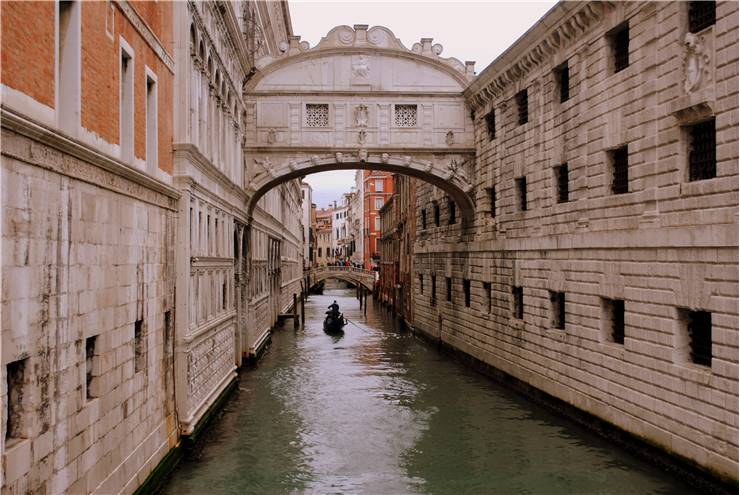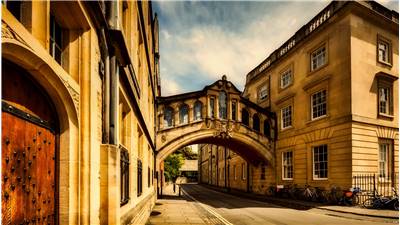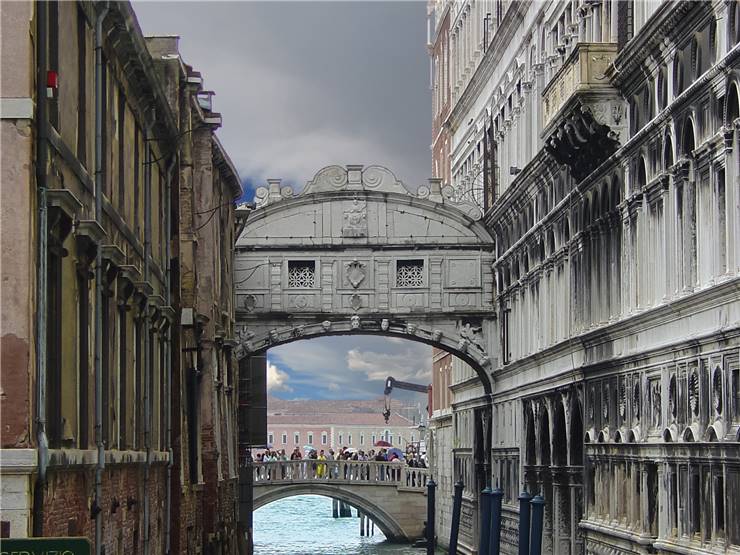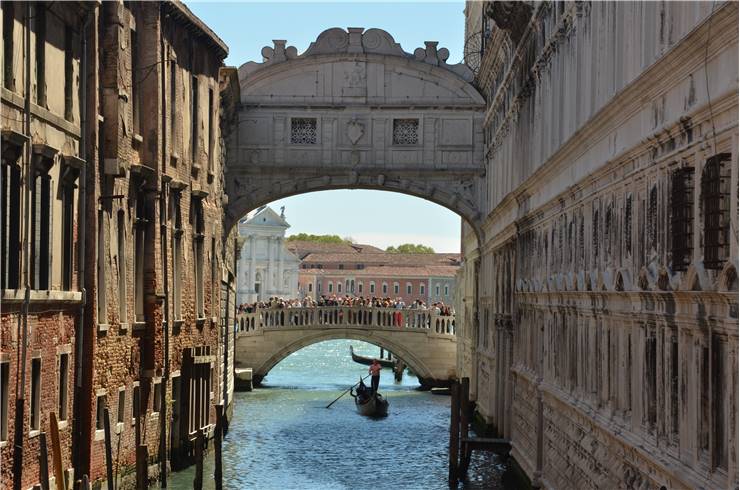Bridge of Sighs - Legend, Design and Interesting Facts
Among many bridges adoring the beautiful city of Venice, one of them managed to capture the imagination of the public in a new and interesting way. This is the famous “Bridge of Sighs”, a bridge that cannot easily be visited on foot because it is a part of a government prison facility built on the waves near the harbor of the city, but is easily accessible via boats that are constantly flowing under it. Built in the early years of 17th century, this fully enclosed bridge made of white limestone has caught the attention of many, including the famous English nobleman and poet Lord Byron who exaggerated in one of his poems in the 19th century, describing this bridge as the last point where condemned prisoners could see the beautiful city of Venice before they were brought to their executioner.
Many believe that Bridge of Sighs is the most beautiful bridge in the entire Venice
So many centuries after it was built, Bridge of Sighs is still the part of the same prison complex that connects the main building of New Prison (Prigioni Nuove), to the nearby interrogation rooms located in the Doge's Palace. The bridge itself is of course not being used for transport of maximum security prisoners but is instead used by small-time offenders who are residing in this low-security prison. The fame of the bridge as the final point of freedom of prisoners may have come up from the early history of Venice and its prison when summary executions and inquisitions were indeed practiced (well before the bridge was ever built).
Bridge of Sighs was built over the Rio di Palazzo between 1600 and 1603 by the instructions of the architect Antonio Contin, nephew of famous Antonio da Ponte who has designed one of the most popular bridges in all of Venice – Rialto Bridge. Antonio Contin designed this 11 meters long bridge to have a single arch, detailed and stylish outdoor decorations made from Istrian stone, and two windows barred with white stone bars on both sides of the walking chamber.
Anyone who wants to personally visit Bridge of Sighs has to take part of "Secret Itinerary" (Itinerari Segreti) tour that is organized by the Doge Palace. The tour that is accessible only between June and September lasts around 90 minutes, it is done only in Italian and includes visiting of the several famous parts of the prison, such as its antique cells, torture chambers, other rooms and of course, the Bridge of Sighs itself. Traveling under the bridge involves much less hassle, enabling anyone interested in baroque bridges of Venice or those interested in numerous urban legends and bridge myths to easily pass under it on their way over Rio di Palazzo.
Location and History
The Doge’s palace has served the function of the city prison ever since the mid-16 th century. Located in the harbor of the Venice at Piazza San Marco 1 (overlooking the St. Mark's Basin), this large palace was home and primary residence of Doge of Venice, the supreme authority of the former Republic of Venice, and a location of the in-city prison. The large palace was built over the ruins of the previous fortress palace that was partially burned in a 10th century. Built with the of Gothic and Baroque influences, Doge’s palace became home of the increasing city’s government and Great Council members.
Bridge of Sighs was commissioned and built over the period of three years, between 1600 and 1603 under the oversight of the designer Antonio Contino who matched the visual style of the bridge with the two objects it connected - Doge's Palace and the facilities of New Prison (Prigioni Nuove).
During its long history, the bridge was initially connected with stories of inmates being transferred through it, managing to glimpse their last look toward beautiful Venice before they were executed. During those moments, prisoners would sight their last breaths of despair. This myth is regarded as the origin of the name of the bridge. In more recent decades, this bridge became connected with modern myths of romance.
Modern Legends
In recent history, numerous mentions of Bridge of Sighs in poems and songs (some written by the famous poet and Latin-lover Casanova who spent 15 months of his life imprisoned in Venice) have solidified a modern legend. In it, lovers will be gifted an eternal love if they kiss on the gondola right under the bridge at the exact moment of sunset and when bells of St Mark’s Campanile can be heard tolling across the beautiful city of Venice.
Tourists from all around the world sail under Bridge of Sighs, seeking eternal love via a well-timed kiss
Today, Bridge of Sighs is viewed less as a remnant of a prison, but more like a symbol of love and romance in a city that attracts lovers and couples.
Style
Even though it is not large or used by common visitors, today many regard Bridge of Sighs as one of the perfect examples of not only the fine architectural design of Renaissance Europe but also as one of the most impressive bridges ever created.
Its baroque visual style makes it one of the most beautiful bridges in all of Venice, with white limestone and striking design that accentuates both buildings it is attached to. One of the most curious details on its surface is 20 macaron faces on the bottom arch of the bridge. Since this is the bridge that was intended to use by prisoners, 10 faces on the bridge show emotions of fear and sadness, while only one face is smiling. Macaron faces are stalwarts of the Italian baroque style, intended to scare evil and top them having access to the buildings and their occupants.
Throughout the entire bridge-building history of Venice, Bridge of Sighs remains the only covered bridge in the entire city. Its passageway is completely covered by stone, with only two windows looking outsides toward the San Giorgio and the Lagoon. Windows are of course very well protected with stony wire netting that passes through very little light. Insides of the bridge feature no artificial illumination.
Similar Bridges
Since Bridge of Sighs is undoubtedly one of the most popular and famous bridges in Venice, it is not strange that other architects tried to emulate it. This led even to the creation of the "Richardson Romanesque" style of bridge building that was practice by American architect Henry Hobson Richardson.
Influence of Bridge of Sighs can today be felt in many cities in the world who feature bridges that are directly made to bring the part of Venice to their city limits. These covered bridges made in Venetian style can be found in Oxford, Chester, Cambridge, Pittsburgh, and countries such as Sweden, Germany, and Scotland. One of the most popular of those bridges is located in Pittsburgh. Architect Henry Hobson Richardson unveiled plans for Allegheny County Courthouse in 1883, which included the bridge of Venetian style (more precisely, almost an exact replica of Bridge of Sighs) that connected courthouse to the county jail building. During many decades, Pittsburgh prisoners were indeed transported through this bridge, but this practice stopped in 1995 when the county jail was moved to another location.
New York also has its Bridge of Sighs, which connects The Tombs (the Manhattan Detention Complex) with the Criminal Courts Building. Las Vegas also has a replica of Bridge of Sighs in their “The Venetian” casino.
Bridge of Sighs Restoration
After decades and centuries of attracting dirt and decay, famous Bridge of Sighs was finally restored in its full glory after an expensive and long rebuilding that was ordered by the governing body of this famous city. Viewed each year by over 12 million tourists, three-year work finally unveiled newly restored bridge that once again shines in pure brilliant Istrian stone like it did when it was originally constructed in 1603.
The restoration was commissioned after parts of the bridge started falling off into the murky water of Rio di Palazzo, one even narrowly missing the leg of the passing tourist on the gondola below it. The restoration process that lasted for three years and with the cost of 2.8 million Euro that was collected with some controversy. Much of the funds were gathered via eye-catching advertisements that were placed on the scaffolding gear around the bridge. Many city residents believed that this advertisement detracted the appearance and decorum of the public area of this beautiful city.
Bridge of Sighs In Culture
Films, Operas, and Music
- 1861 opera “Le pont des soupirs” features Bridge of Sighs
- Song “Venice” by Gibraltarian band Melon Diesel
- 1925 and 1936 Hollywood drama films “The Bridge of Sighs” center around the bridge of the same name that is located in New York City
- Bridge of Sighs is featured in of Robin Trower’s 1974 album of the same name
- 1900 song by James Thornton
Books and Poems
- “Childe Harold’s Pilgrimage”, a 19th century poem by Lord Byron, which served as the origin of the modern name of this bridge.
- “Bridge of Sighs” poem by Thomas Hood
- “Bridge of Sighs”, a novel by Richard Russo
- “Bridge of Sighs”, a novel by Olen Steinhauer
- “Bridge of Sighs”, a novel by Jane Lane
- 'Le pont des soupirs (The Bridge of Sighs), a novel by Michel Zevaco
Critics
- “History of my life”, an autobiography of 18th century Italian adventurer Giacomo Casanova. He described walking across it during his imprisonment in Venice.
- 1845 diary of leading English art critic of the Victorian era, John Ruskin mentioned Bridge of Sighs. He described it in a very romantic light.
- French poet and critic André Suarès described the Bridge of Sighs as the “sarcophagus which flies away”.
- Critic Adolphe Lance described the look of the Bridge of Sighs in his 1859 book “Excursions in Italy”.
Video Games
While the many parts of the Renaissance city of Venice were featured in the video game Assassins Creed 2, the Bridge of Sighs was not shown.



